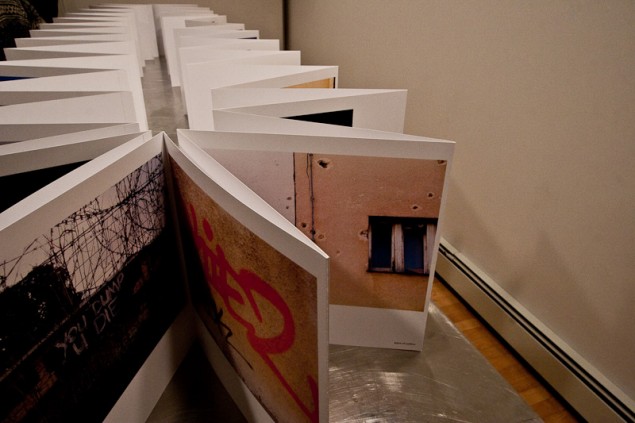
photos by Benjamn Lozovsky
What happens when art and science collide? In “The Visual Collider,” a modern interpretation of an age-old question, artists Nina Czegledy and Marcus Neustetter are hoping for a Big Bang.
The Hungro-Canadian and South African artists, respectively, discussed their ongoing collaborative project during a lecture and reception at exhibition space Alma On Dobbin in Greenpoint, Brooklyn, last Thursday, January 7. Based on the Large Hadron Collider (the astronomically complex and expensive scientific mega-experiment that is attempting to recreate the conditions of the first moments of our Universe’s existence by smashing atomic particles together at incredibly fast speeds), “The Visual Collider” is the pair’s attempt to reconcile, artistically, the moment when the confluence of matter, or in this case photographic light, cease to be disparate identities and instead become one object.

This is achieved through a series of visual mash-ups of plain, unadorned photographic source material. More exactly, it is an ironic, purposely low-tech reconstruction, combining snapshot photography taken during the two artists’ many travels, through both overlay (in the form of bare-boned projections) and juxtaposition (in a foldout book of images, the stronger element of the installation).

While reading a methodically detailed and somewhat quixotic artist statement, Czegledy and Neustetter revealed their mix of enthrallment and distaste for the LHC, an undertaking some critics have called quasi-religious. While it’s not completely evident what ratio those dualistic feelings end up at in the artists’ minds, the simplistic yet appealing end result is more readily accessible. Even if many of the photographic pairs are predictable (think shots of planes and Arabic imagery, bullet hole ridden walls and a South African populace), the pictures are captivating (especially noteworthy coming from a pair with no photographic background), and their combination stirs unavoidable feelings about how we view the world.
As the exhibit travels around the world (this was the second stop after the premier in Croatia last September), mimicking the 17 mile trajectory of the particles in the LHC, Czegledy and Neustetter plan on changing the way their images are combined. In that sense, it provides more questions for both the artist and viewer then it does answers. Which would appear to make it a scientific exploration of note.
Leave a Reply